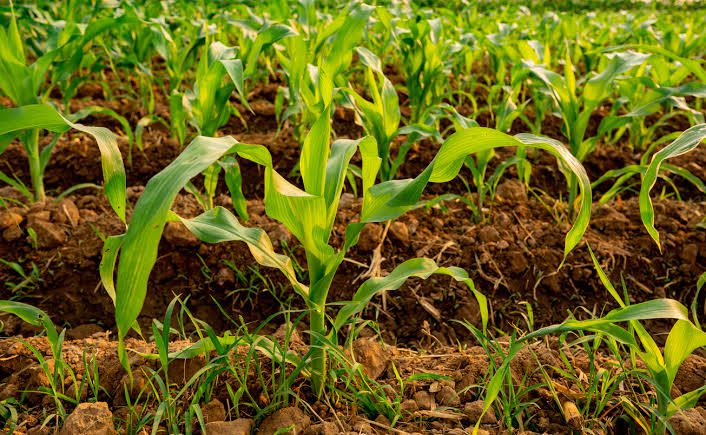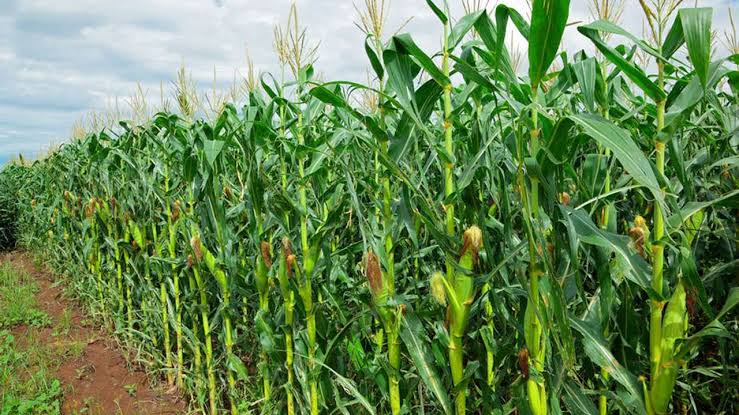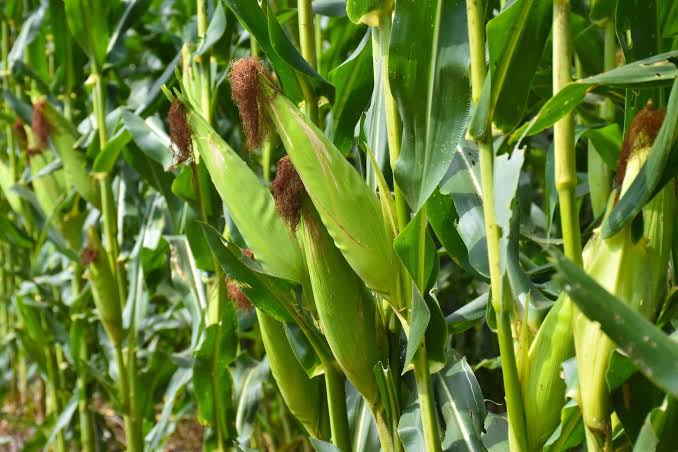Maize, often called corn, is a tall grass plant that produces large ears containing edible kernels. This versatile crop has been a significant part of human diets and cultures for centuries.
Maize grows in many places around the world, thriving in warm climates. It’s known for its distinctive, tall stalks and broad, elongated leaves. The plant undergoes a remarkable transformation from a tiny seed to a mature corn plant with ears full of plump kernels.
One of maize’s primary uses is as a food staple. The kernels, commonly yellow but available in various colors, are rich in nutrients like carbohydrates and fiber. People consume maize in various forms, from corn on the cob to cornmeal, which is used to make cornbread and other delicious dishes.
Farmers play a crucial role in cultivating maize. They plant seeds in rows, ensuring proper spacing for optimal growth. Maize requires sufficient sunlight and water to flourish. As the plant matures, it develops tassels that produce pollen, contributing to the pollination process, leading to the formation of corn kernels.
Apart from its role in human nutrition, maize is a valuable crop in the agricultural industry. It serves as livestock feed, providing essential nutrients for animals like cattle and poultry. Additionally, maize is a source of various by-products, including corn oil and corn syrup, which find applications in cooking and food processing.
The significance of maize extends beyond the kitchen and farm. In some cultures, maize holds symbolic importance and is used in rituals and ceremonies. Its presence in traditional festivals and celebrations highlights its cultural relevance and the deep connection between people and this crop.
Maize also plays a crucial role in global trade. Countries that excel in maize production often export surplus crops to meet the demand in other regions. This interdependence fosters economic ties and contributes to the global food supply chain.
In recent years, scientific advancements have led to the development of genetically modified maize varieties, designed to resist pests or enhance nutritional content. These innovations aim to address challenges such as crop diseases and nutritional deficiencies, potentially improving the sustainability of maize cultivation.
Maize is more than just a cereal; it is a vital part of human history, diets, and economies. Its versatility, from food to industrial applications, makes it a cornerstone in agriculture worldwide. As we continue to explore ways to enhance crop yield and sustainability, maize remains a staple that connects us to our agricultural roots.
The journey of maize doesn’t end with its cultivation and harvest. Once the maize is ready for harvest, farmers carefully gather the mature ears, often during the autumn season. Harvesting involves removing the ears from the stalks and collecting them for further processing.
Post-harvest processing is a crucial step in preparing maize for consumption and various applications. Farmers may dry the harvested ears to reduce moisture content, preventing mold and ensuring better storage. Dried maize can then be stored for longer periods, providing a reliable food source throughout the year.
Maize processing extends to milling, where the dried kernels are ground to produce flour or meal. This versatile maize flour becomes the base for numerous food products, ranging from tortillas to polenta. The milling process also extracts components like cornstarch and cornmeal, which have diverse industrial uses.
In addition to traditional uses, maize has found its way into modern industrial applications. Cornstarch, for example, is utilized in the production of biodegradable plastics, contributing to efforts to reduce environmental impact. Maize’s adaptability makes it a valuable resource not only in kitchens but also in laboratories and factories.
The livestock industry heavily relies on maize as a feed source. Maize silage, a fermented feed product made from chopped maize plants, is particularly popular in animal husbandry. It provides a nutritious and energy-rich diet for cattle during periods when fresh forage is scarce.
Beyond its practical applications, maize has become a subject of scientific research, aiming to unlock its full potential. Scientists explore ways to enhance maize’s resistance to pests and diseases, improve yield, and adapt it to changing environmental conditions. These efforts contribute to global food security and sustainable agriculture.
However, maize’s significance goes beyond its presence on dinner plates. From fields to laboratories, it plays a multifaceted role in our lives. As we continue to advance scientifically and culturally, maize remains a symbol of agricultural ingenuity, providing sustenance, economic stability, and avenues for innovation. Its journey from seed to table reflects not just a crop but a dynamic force woven into the fabric of human existence.
Read Also: Principles of Housing and Sanitation for Rabbits
How to Grow and Care for Maize

Growing and caring for maize, commonly known as corn, involves several key steps to ensure a successful crop. Here’s a basic guide:
1. Choosing the Right Location: Maize requires a sunny location with well-drained soil. Ensure the soil is rich in organic matter and has a slightly acidic to neutral pH level.
2. Planting:
Timing: Plant maize after the last frost when the soil has warmed up. This is typically in late spring or early summer.
Spacing: Plant seeds in rows, leaving sufficient space between each plant. Adequate spacing promotes proper airflow and prevents competition for nutrients.
3. Soil Preparation:
Fertilization: Maize is a heavy feeder, so provide a balanced fertilizer before planting. Consider side-dressing with nitrogen as the plants grow.
Soil Moisture: Ensure consistent soil moisture, especially during the germination and tasseling stages. Maize requires about 1-1.5 inches of water per week.
4. Planting Depth: Plant maize seeds about 1-2 inches deep. Planting depth is crucial for germination and early growth.
5. Weed Control: Keep the area around maize plants free of weeds, especially during the early stages of growth. Weeds compete for nutrients and water.
6. Tending to Growing Plants:
Thinning: Once seedlings are a few inches tall, thin them to ensure proper spacing between plants.
Hilling: As the plants grow, consider hilling soil around the base to provide support and encourage stability.
7. Pollination: Maize is wind-pollinated. Ensure good tassel development for pollen and proper silk formation on the ears. Adequate spacing between rows can enhance wind pollination.
8. Pest and Disease Management: Monitor for pests like corn borers and aphids. Consider natural predators and organic methods for control. Rotate crops to reduce the risk of soil-borne diseases.
9. Harvesting: Harvest maize when the ears are fully formed, and the kernels are plump. The silk on the ears should be dry and brown. Peel back the husk to check for maturity.
10. Storing: After harvesting, dry the maize thoroughly before storage. Properly dried maize can be stored for an extended period.
11. Crop Rotation: To prevent soil depletion and minimize disease risks, rotate maize with other crops in subsequent growing seasons.
By following these steps and adapting them to your specific climate and soil conditions, you can successfully grow and care for maize, enjoying a bountiful harvest of fresh and nutritious corn.
Uses of Maize

Maize, also known as corn, has lots of different uses that make it important for many things. People all around the world use maize in various ways because it’s versatile and can be helpful in different areas of life.
1. Eating: People eat maize in many ways. They can have it as corn on the cob or use cornmeal to make tasty foods like cornbread or tortillas. Popcorn, which is a fun snack, also comes from maize.
2. Feeding Animals: Farmers give maize to animals like cows and chickens. The animals like to eat it, and it gives them good nutrients to stay healthy.
3. Making Things: Maize is used to make different things that we use every day. Cornstarch, which comes from maize, helps make products like biodegradable plastics, adhesives, and textiles.
4. Fuel: Some people use maize to make biofuel, which is like a special kind of fuel that comes from plants. It’s better for the environment than regular fuel.
5. Cooking Oils and Syrups: Maize is used to make cooking oils and syrups. These are ingredients in many foods and recipes we enjoy.
6. Snacks: Maize is in many tasty snacks. Think of your favorite corn chips or popcorn at the movies – those come from maize too.
7. Traditional Use: In some cultures, maize is important for traditions and ceremonies. People use it in special ways to celebrate and connect with their history.
8. Drinks: Maize is even used to make drinks. Some cultures have special corn-based drinks, and maize is used in the making of some traditional alcoholic beverages.
9. Trade: Countries trade maize with each other. This means that if one place has a lot of maize, they can send it to another place that might need more.
10. Research: Scientists study maize to make it even better. They try to make new kinds of maize that can resist bugs and grow in different conditions. This helps farmers and makes sure we have enough food.
Maize is like a helpful friend that we can use in so many ways. From our dinner tables to making important things, maize is part of our lives in many different and interesting ways.
Read Also: Rabbit Feeds and Feeding Guide
Economic Importance of Maize

Maize holds significant economic importance due to its versatile applications across various industries. Let’s explore the key aspects that contribute to the economic significance of maize:
1. Food Production: Maize is a staple food for many people globally. Its use in various food products, including cornmeal, cornflour, and snacks, contributes to the food industry’s economic growth.
2. Livestock Feed: Maize is a crucial component of animal feed, supporting the livestock industry. Its use as feed for cattle, poultry, and other animals contributes to the economic viability of livestock farming.
3. Industrial Processing: Maize-derived products, such as cornstarch and corn oil, are extensively used in industrial processes. These products are essential ingredients in the production of biodegradable plastics, adhesives, and various food items, adding economic value to these industries.
4. Biofuel Production: Maize plays a role in the production of biofuels, including ethanol. As the demand for renewable energy sources increases, the economic importance of maize in biofuel production grows.
5. Export and Trade: Countries that produce surplus maize often engage in international trade, exporting maize to regions with higher demand. This trade contributes to economic growth and strengthens global economic ties.
6. Employment Opportunities: Maize cultivation and its associated industries, including processing and distribution, create employment opportunities. This helps support rural economies where maize farming is prevalent.
7. Research and Innovation: Scientific research focused on improving maize varieties contributes to agricultural innovation. The development of genetically modified maize with enhanced resistance and yield potential can positively impact crop productivity, benefiting farmers and the economy.
8. Agricultural Infrastructure: The cultivation of maize requires a well-developed agricultural infrastructure, including machinery, storage facilities, and transportation. The investment in such infrastructure stimulates economic activity and supports rural development.
9. Value-Added Products: Maize serves as a raw material for the production of various value-added products, including cooking oils, syrups, and snacks. The processing and manufacturing of these products contribute to economic diversification and growth.
10. Stability in Food Prices: Maize’s role as a stable food crop helps regulate food prices. A consistent and reliable maize supply can contribute to food security and mitigate the impact of fluctuations in the prices of other crops.
In summary, the economic importance of maize extends beyond its role as a basic food crop. Its contributions to various industries, trade, employment, and research make maize a key player in the economic development of regions where it is cultivated and processed.
Read Also: Types and Sources of Waste-Water
